Abstract
Gun violence and, most recently, senseless shooting rampages continue to be sensitive and emotional points of debate in the American media and the political establishment. The United Nations is already set to commence discussing and approving its Small Arms Treaty in March 2013. And following the Newtown, Connecticut tragedy in the United States this past December, American legislators are working frantically to pass more stringent gun control laws in the U.S. Congress.
The American media and proponents of gun control assert that the problem lies in the “easy availability of guns” and “too many guns” in the hand of the public. Second Amendment and gun rights advocates, on the other hand, believe the problem lies elsewhere, including a permissive criminal justice system that panders to criminals; the failure of public education; the fostering of a culture of dependence, violence, and alienation engendered by the welfare state; and the increased secularization of society with children and adolescents growing up devoid of moral guidance. I cannot disagree with the latter view, but I believe there are additional, contributing, and more proximate causes — e.g., failures of the mental health system and the role of the media and popular culture in the sensationalization of violence — that also need to be specifically pointed out and discussed in the medical literature, as I have set out to do in this review article.
Keywords: Gun violence, gun control, rampage shooting, media sensationalism, mental health, Second Amendment
INTRODUCTION
The debate on the role of firearms in society has returned with a fury in the United States and the world with the latest shooting rampage in Connecticut. Politicians are once again calling for gun control without examining other psychosocial factors that play a tremendous role in gun violence.
The shooting rampage at Sandy Hook Elementary School in Newtown, Connecticut, on December 14, 2012 in which 6 adults and 20 children were killed, was indeed a senseless tragedy, and like previous mass shootings, words cannot convey the horror and the magnitude of the loss of innocent life. This second deadliest mass shooting in U.S. history was carried out by 20-year-old Adam Lanza, a loner with a personality disorder — and in critical need of mental health evaluation and psychiatric treatment [Figure 1]. Once again, evidence mounts that these deadly rampages are the result of failure of the mental health system in association with, as we will suggest in this article, the systematic sensationalization of violence by the media and popular culture.
Figure 1.
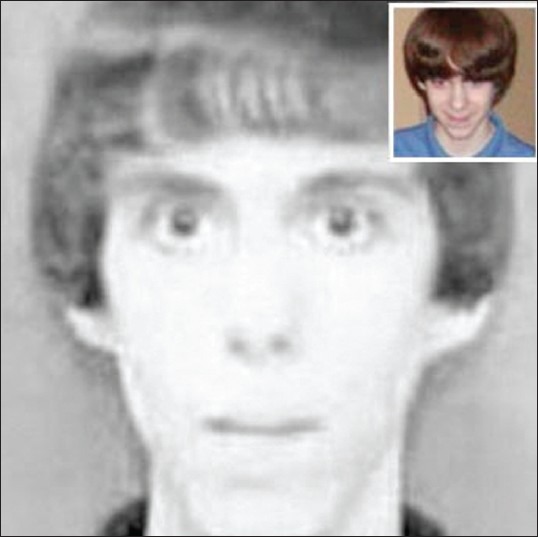
Adam Lanza, 20-year-old loner who carried out the shooting rampage at Sandy Hook Elementary School in Newtown, Connecticut in December 2012
Let's revisit the case of Jared Loughner, the 22-year-old disturbed individual who shot former U.S. Representative Gabrielle Giffords in Arizona in 2011. He also killed 5 people, including an innocent 9-year-old student and a judge, and wounded 14 others. Prior to the shooting, there were signs of psychiatric illness and social psychopathology that should have alerted those around him that Loughner should have been referred for mental evaluation and psychiatric treatment. But Loughner, like Lanza, fell through the obvious cracks.
The case of Loughner in Arizona [Figure 2] is particularly revealing because a consensus has been reached that the mentally deranged individual should have received psychiatric evaluation and treatment, which were not administered.[2] The same conclusion is being reached as more information is rapidly coming to light in the latest rampage by Adam Lanza in Connecticut.
Figure 2.
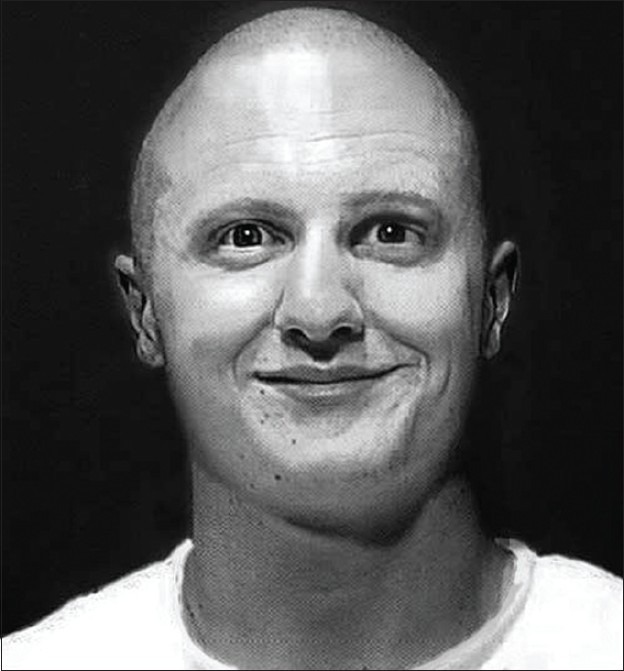
Jared Loughner, 22-year-old disturbed individual who shot former U.S. Representative Gabrielle Giffords in Arizona in 2011
“Convicted felons and mentally unstable people,” as I stated in a previous article, “forfeit the right to possess arms by virtue of the fact they are a potential danger to their fellow citizens. This has been demonstrated recently by the tragedies that took place in Arizona and in Aurora, Colorado [Figure 3]; and not only in the United States, but also in Oslo, Norway.”[3]
Figure 3.
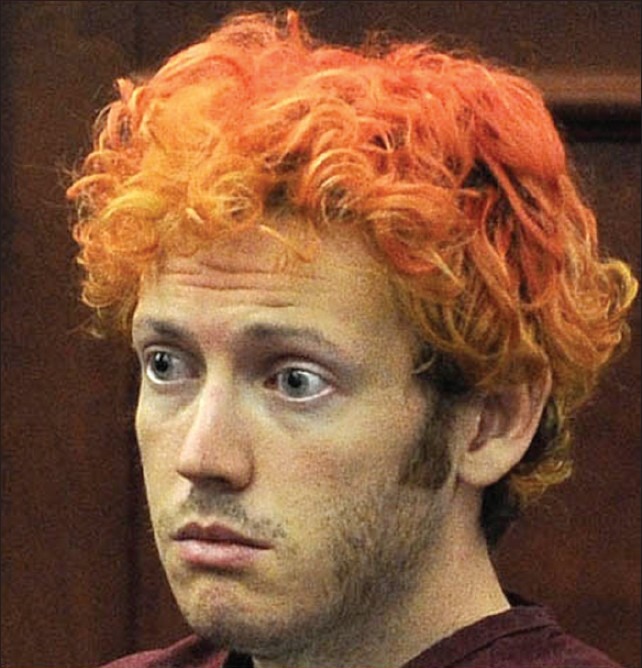
James Holmes, 26-year-old suspected perpetrator of the mass shooting at a movie theater in Aurora, Colorado in 2012
The case of the senseless massacre in Norway on July 22, 2011 is instructive. After bombing a government building in Oslo and then taking over an island, Anders Behring Breivik, a homicidal killer, massacred 69 of his fellow citizens, systematically hunting down unarmed youths at a camp, methodically killing mostly defenseless teenagers [Figure 4]. Imagine if just one person had carried a gun and knew how to use it to defend his or her life and the lives of others! But Norway, for all practical purposes, like most of Europe, is like the schools in the U.S., a “gun-free zone,” where guns are not allowed and a deranged individual can enter and kill with impunity.
Figure 4.
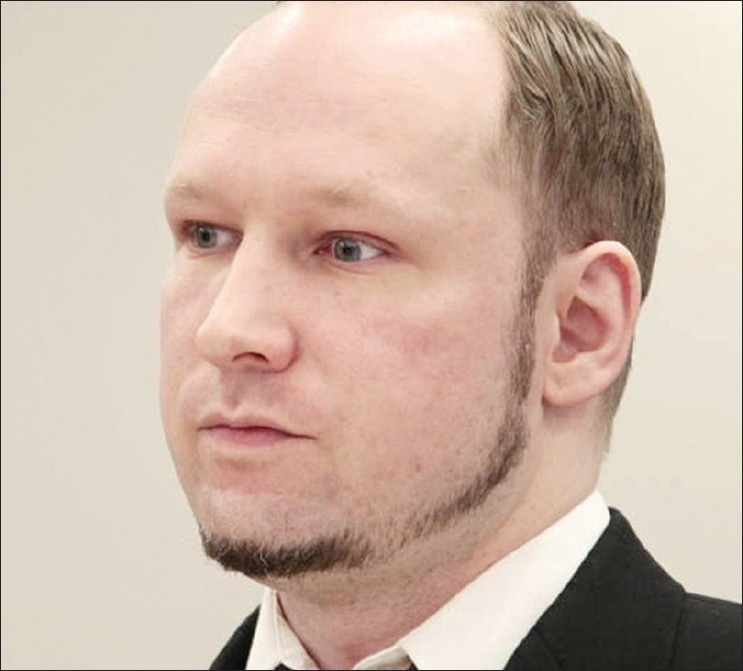
Anders Behring Breivik, 33-year-old perpetrator of the Norwegian massacre in 2011
Investigation and further legal developments in these three aforementioned incidents represent cases of criminal insanity associated with regrettable failures in the mental health system, rather than the assignation of blame with the easy cliché of “too many guns” in the hands of people. In my article, “America, Guns and Freedom,” I also cite other recent cases, including the two reciprocal incidents that occurred in Aurora, Colorado, in the spring and summer of 2012. One incident was widely reported; the other, where a citizen stopped a rampage and saved the lives of others, was not.[1] In the U.S., the vast majority of citizens who hunt, participate in shooting sports, and most importantly, those who possess firearms in their homes for family protection or legally carry concealed weapons for self-protection, use firearms responsibly.[3,4,7,17,21]
SHOOTING RAMPAGES AND THE ARMED CITIZEN
In 2000 a New York Times study revealed that in 100 cases of rampage shooting incidents, 63 involved people who “made threats of violence before the event, including 54 who threatened specific violence to specific people.” Nothing had been done about the threats. Moreover, over half of the shooters had overt signs of mental illness that had gone untreated. For these troubled individuals, a precipitating event in association with failures in life and long-term mental illness finally triggers the shooting rampage, giving “the appearance of being at the same time deliberate and impulsive.”[8]
A more recent study by Mother Jones magazine also suggests the majority of mass shooters in the past 30 years evinced signs of mental health problems prior to the killings. This conclusion is supported in the medical and legal literature. While the figures in the Mother Jones article are for the most part correct, unfortunately the analysis and conclusions are not because, like many other studies on gun violence, they are tainted by passion and ideology, resulting in overt biased and result-oriented, preordained conclusions.[10] For example, while it is true that the number of shooting rampages has increased in recent years, the rate of violent crimes and homicides for both Blacks and Whites (including those committed with firearms) has decreased significantly over the same period, despite the tremendous increase in the number of firearms in the U.S., according to both the FBI Uniform Crime Reports and the U.S. Bureau of Justice Statistics.[9,18–20] [Figure 5] In fact, the number of firearms has increased from approximately 200 million in 1995 to 300 million in 2012, in association with a significant decrease not only in violent crimes [Figure 6] but also in all property crimes [Figure 7] since 1990 to the present.[18–20]
Figure 5.
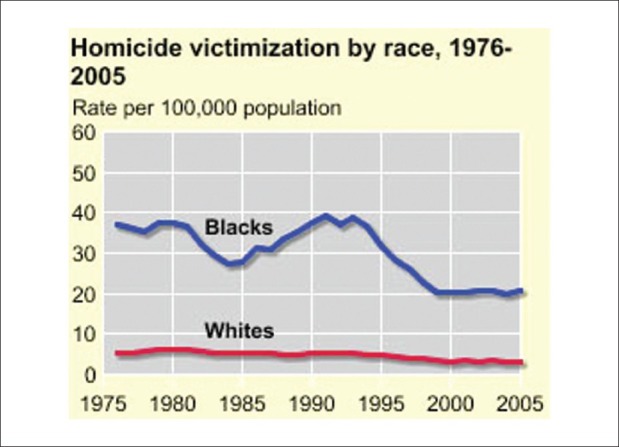
Homicide victimization rates in the United States per 100,000 population by race, 1976–2005. Source: US Bureau of Justice Statistics
Figure 6.
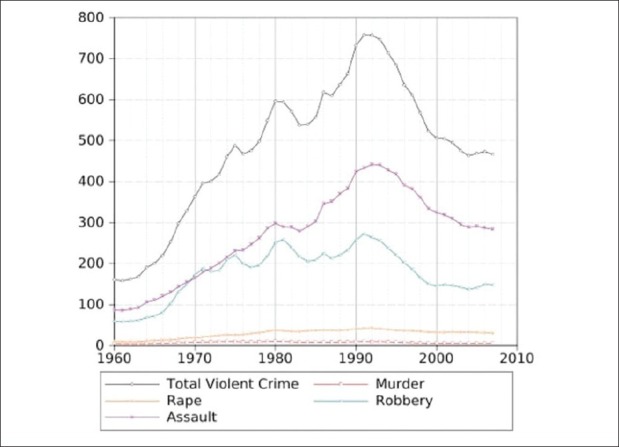
Violent crime rates in the United States per 100,000 population beginning in 1960. Source: US Bureau of Justice Statistics
Figure 7.
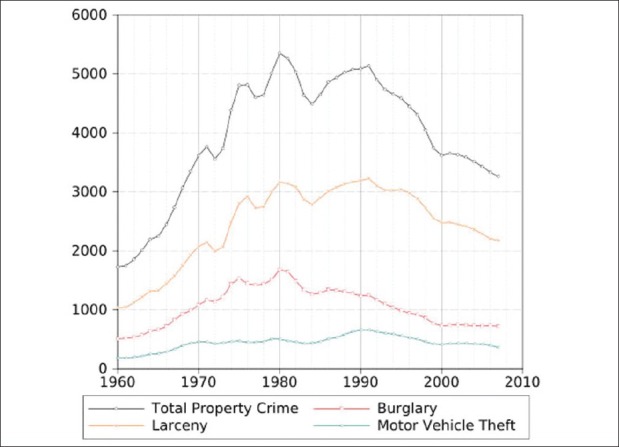
Property crime rates in the United States per 100,000 population beginning in 1960. Source: US Bureau of Justice Statistics
I would also be remiss if I did not point out the Mother Jones article was incorrect when it also claimed, “in not a single case was the killing stopped by a civilian using a gun.”[10] Consider the following cases:
In November 1990, Brian Rigsby and his friend Tom Styer left their home in Atlanta, Georgia, and went camping near Oconee National Forest, not too far from where I live in rural Georgia. Suddenly, they were assaulted by two madmen, who had been taking cocaine and who fired at them using shotguns killing Styer. Rigsby returned fire with a Ruger Mini-14, a semiautomatic weapon frequently characterized as an assault weapon. It saved his life.[16]
In January 1994, Travis Dean Neel was cited as citizen of the year in Houston, Texas. He had saved a police officer and helped the police arrest three dangerous criminals in a gunfight, street shooting incident. Neel had helped stop the potential mass shooters using once again semiautomatic, so-called assault weapons with high capacity magazines. He provided cover for the police who otherwise were outgunned and would have been killed.[21]
The January 16, 2002, case of three law students at the Appalachian School of Law in Grundy, Virginia, who prevented a mass shooting, is very interesting. The media reported the incident but left out one inconvenient detail. According to the Washington Post, they “pounced on the gunman and held him until help arrived.” What the media left out was the fact that one of the students was armed, and thus they felt safer in carrying out the courageous act they performed. In his book, scholar John Lott recounts the incident: “Mikael and Tracy were prepared to do something quite different: Both immediately ran to their cars and got their guns. Mikael had to run about one hundred yards to get to his car. Along with Ted Besen [who was unarmed], they approached Peter [Odighizuwa, the gunman] from different sides. As Tracy explains it, ‘I stopped at my vehicle and got a handgun, a revolver. Ted went toward Peter, and I aimed my gun at [Peter], and Peter tossed his gun down. Ted approached Peter, and Peter hit Ted in the jaw. Ted pushed him back and we all jumped on.’”[13]
In 2007, a brave woman, Jeanne Assam, a former police officer who had volunteered to work security at the New Life Church in Colorado Springs, Colorado, prevented a shooting rampage when she shot and killed a man storming the building who intended to kill as many people as possible at her church.[15]
Just days after the recent Connecticut shooting, an off-duty police officer prevented a shooting rampage at the Mayan Palace Theater in San Antonio, Texas, by shooting the gunman before he had a chance to kill anyone.[15] This incident “sparks memories” of the mass slaying at "the gun-free zone" Cinemark movie theater in Aurora, Colorado, that I discussed elsewhere.[3] I also noted then how the media did not report another shooting incident that took place 3 months earlier (April 2012) in the same town, Aurora, Colorado, where a law-abiding citizen, an armed church-goer, shot another human predator and stopped a shooting rampage, saving his life and the lives of others in the process.[1]
OTHER INSTRUCTIVE (BUT FORGOTTEN OR IGNORED) CASES
In that same article,[3] I discussed the following additional cases that I now report verbatim since the inconvenient details of armed citizens saving lives were ignored, not only by the investigative journalists of the mainstream media, but also missed by the Mother Jones study, that claimed “in not a single case was the killing stopped by a civilian using a gun.”[10] Thus consider further the following incidents:
In 1997, in Pearl, Mississippi, 16-year-old Luke Woodham used a hunting rifle to kill his ex-girlfriend and her close friend and wound 7 other students. Assistant Principal Joel Myrick retrieved his handgun from his automobile and halted Woodham's shooting spree. Myrick held the young delinquent at bay until the police arrived. Later it was discovered that Woodham had also used a knife to stab his mother to death earlier that morning. Even though this shooting incident was widely reported, the fact that Mr. Myrick, an armed citizen, had prevented a larger massacre by retrieving and using his handgun was ignored by the media.
Then in 1998, in Edinboro, Pennsylvania, a deadly scenario took place when 14-year-old Andrew Wurst killed 1 teacher and wounded another, as well as 2 fellow classmates. The Edinboro shooting rampage was halted by a local merchant, James Strand, who used his shotgun to force the young criminal to halt his firing, drop his gun, and surrender to the police.
And in another unreported incident in Santa Clara, California, Richard Gable Stevens rented a rifle for target practice at the National Shooting Club on July 5, 1999, and then began a shooting rampage, herding 3 store employees into a nearby alley, and stating he intended to kill them. When Stevens became momentarily distracted, a shooting club employee, who had a .45 caliber handgun concealed under his shirt, drew his weapon and fired. Stevens was hit in the chest and critically wounded. He was held at bay until the police arrived. A massacre in the making was prevented. The deed performed by the armed employee, an unsung hero, was ignored by the press. Why are these and other similar incidents, where the tables are turned, and citizens use guns to protect themselves and others, only seldom reported by the mainstream media?[3,7]
The fact, as we have recounted here, is that many crimes and shooting rampages have been prevented or stopped by armed citizens. Consider the case at the Clackamas Mall in Oregon in December 2012, where another shooter murdered 2 people. The deranged killer, after realizing another shopper (a concealed carry permit holder) had pulled a handgun and was aiming at him, then turned the gun on himself.[12] As with all types of crimes, the police cannot be everywhere at all times to protect us. By the time the police arrive at a crime scene, most dramatically at a shooting rampage, it's usually too late for the victims. An armed citizen could already be there, identify the shooter, and at least stop the carnage. Only if one of the intended victims already at the scene is armed, can he or she prevent or stop the shooting, as in some of the cases described above.[1,11–13,15–17,21]
The incidence of mass shootings with the usual intensive media coverage and sensationalization give the impression that we are about to be swamped by shooters. The truth is that the incidence of mass shootings is very low by any standard. John Fund, a former columnist for The Wall Street Journal and distinguished National Review Online (NRO) columnist, correctly notes, “The chances of being killed in a mass shooting are about what they are for being struck by lightning.” And despite the draconian gun control laws in Europe, “until the Newtown horror, the three worst K–12 school shootings ever had taken place in Britain and Germany.”[11] Moreover, the Norway massacre of July 22, 2011, described previously claimed a total of 77 lives, mostly teenagers. These statements are not repeated here to trivialize shooting tragedies nor intended to detract from the need to be concerned about them, but to place the matter in a more precise sense of statistical proportion and recognize that the rest of the world, including those with strict gun control laws, is not immune.
In the wake of the Connecticut shooting, the National Rifle Association (NRA) has called for armed guards to protect all schools in the United States. In the short term, this may be a good idea, but is it feasible? We could begin by hiring security guards and police officers, but the police are stretched to the limit as it is, and budgets are tight with the American middle class already squeezed dry sustaining a myriad of entitlement and social welfare programs. Thus, I suggest the employment of volunteer citizens, who must be psychologically evaluated and trained in the use of firearms and gun safety, to serve as “school sentinels,” as well as allowing qualified teachers to carry guns for student protection. The extra training is a precaution. According to a study conducted between 2005 and 2007 by researchers at the University of Wisconsin and Bowling Green State University, the police across the country were convicted of firearm violations at an 0.002% annual rate, which is about the same rate as concealed-carry gun permit holders in the states with “shall issue” laws.[11] Research conducted by criminology professor Gary Kleck and constitutional lawyer Don. B. Kates has shown that firearms are used more frequently by law-abiding citizens to repel crime than used by criminals to perpetrate crime. Moreover, Professor Kleck has noted: “Citizens acting in self-defense kill about three times more assailants and robbers than do the police.” And so it is not surprising that in a survey of 1800 prison inmates, 81% agreed that a smart criminal tried to find out if his potential victim is armed, 74% said that burglars avoid houses when people are home because they fear being shot, and 34% admit to having been scared off, shot at, wounded, or even captured by armed citizens.[4]
Jim Kouri, the public information officer of the National Association of Chiefs of Police, told Fund at the time of the theater shooting in Aurora, Colorado: “Preventing any adult at a school from having access to a firearm eliminates any chance the killer can be stopped in time to prevent a rampage.”[11] In fact police, occasionally outgunned by criminals, have also been assisted by armed citizens, although again these incidents have been downplayed by the mainstream media.[4,21]
THE DE-INSTITUTIONALIZATION OF THE MENTALLY ILL
The United States is a Federal Republic, and the 50 states of the Union have some leeway in passing and enforcing gun laws. In America, we already have 20,000 gun laws on the books. We do not need more statues. The societal failure for violence, with guns or otherwise, lies elsewhere. The killer in Connecticut operated with impunity in a state that does not easily allow people to carry guns for self protection, and most states in the U.S. already have a “zero tolerance” for guns in schools, which amount to “gun-free zones” where firearms are strictly prohibited. This is another reason for proposing that we consider allowing teachers to have special concealed carry firearm licenses to defend students. It would be a sensible and easy strategy to protect the children in this mad, dystopic world we are creating in which we are too permissive to criminals and protective of the rights of deranged individuals, while we easily blame and propose more laws and controls to limit the rights of the lawful citizens in society at large.
Guns are inanimate objects. The responsibility for crimes rests on the criminals and those who facilitate their crimes! Elsewhere, I have discussed failures in the criminal justice system, leniency and use of revolving prison doors that allow many of the same criminals to commit the vast majority of serious crimes.[4] I would like to now elaborate on the aforementioned failures in the mental health system.
The problem with the de-institutionalization of mental patients, which began in America in the 1960s and put thousands of mental patients including dangerous ones back on the streets, has only worsened in recent years. This has happened not only because of the more recent drive for containment of health care costs, but also because of the decades-long, misguided mental health strategy of administering mental health care via community outreach and outpatient treatment. In many cases, these strategies have failed due to inadequate follow-up of and poor compliance by patients as well as legal restraints placed on families.
Another problem is the current privacy laws in association with the forced legal emancipation of children from their parents in educational and health care laws, which have caused difficulties for parents in obtaining confidential mental health records of their children, even those who are young adults and still dependent upon them for health insurance coverage. With the passage of the ObamaCare law requirements, children up to age 26 can be covered under the parent's health insurance. This offers an opportunity to amend privacy laws to allow parents access to the mental health information on their dependent children. ObamaCare or not, these problems need to be corrected by relaxing privacy laws, allowing parents to exert more control of their children in the psycho-socially challenging, difficult years of adolescence and young adulthood when many cases of schizophrenia and other psychopathology first become apparent.
Family members and neighbors should not fear reporting, in good faith, individuals with a history of violence and possible mental illness to the appropriate law enforcement and mental health agencies with the removal of potential legal repercussions.
Moreover, legal impediments to medical commitment for those in need of long-term psychiatric hospitalization should be removed. Steven P. Segal of the University of California at Berkeley has shown that “a third of the state-to-state variation in homicide rates was attributable to the strength or weakness of involuntary civil-commitment laws.”[12] David Kopel, coauthor of the law school textbook, Firearms Law and the Second Amendment (Aspen, 2012), has correctly noted the detrimental drastic drop in long-term institutionalization of the mentally ill:
“In the mid-1960s, many of the killings would have been prevented because the severely mentally ill would have been confined and cared for in a state institution. But today, while government at most every level has bloated over the past half-century, mental-health treatment has been decimated.” Kopel then cites the dramatic statistics released by the Treatment Advocacy Center in July 2012: “The number of state hospital beds in America per capita has plummeted to 1850 levels, or 14.1 beds per 100,000 people.”[12]
THE SENSATIONALIZATION OF VIOLENCE IN THE MEDIA AND POPULAR CULTURE
Finally, there is another even more sinister and perhaps more insoluble contributing factor — namely, the problem of how the media report and how popular culture sensationalize violence, which in association with the fruitless pursuit of celebrity status in vogue today is all pervasive. What more evidence is needed for the “fifteen minutes worth of fame” phenomenon[5] than the immense popularity of vulgar "reality" television shows? It is not a big step to link extensive coverage of shooting rampages in both the press and the colorful electronic media as a major contributing factor in the pathologic and even morbid attainment of celebrity status even in death.
I have previously reported on the excellent work of Dr. Brandon Centerwall of the University of Washington School of Public Health. Centerwall's studies found that homicide rates in Canada were not related to easy gun availability in ordinary citizens, as he had expected, but to criminal behavior associated with watching television. He found homicide rates, not only in Canada but also in the U.S. and South Africa, soared 10–15 years after the introduction of television in those countries.
In the U.S., there was an actual doubling of homicide rates after the introduction of television. Moreover, Centerwall noted that up to half of all homicides, rapes, and violent assaults in the U.S. were directly attributed to violence on television. And that was when violence on TV was nothing compared to the rampant and graphic violence depicted today in the movies, on TV, and now on the Internet.[6]
In 2004 Loren Coleman also reminded us of the copycat effect as a social phenomenon incited by the way the media report the news and the velocity with which it travels in modern society in the information age. Serial killers and shooting rampages have also been subject to the copycat phenomenon because of the sensationalization of violence. Coleman relates that copycat incidents are not new to the 21st century. In 1774 Johann Wolfgang von Goethe's publication of the romantic tragedy, “The Sorrows of Young Werther,” triggered a number of copycat suicides in Europe in the late 18th century.[12]
While the media has sensationalized violence and the mass shootings of hapless victims (who are soon virtually forgotten), as we have seen they have not given defensive, beneficial uses of firearms (e.g., protecting or saving lives and property) the attention these positive acts deserve, which usually go unreported. By and large, to read about the cases where law-abiding citizens use firearms for self and family protection, one has to read independently published books, such as Robert A. Waters’ excellent tome, The Best Defense.[16,21] Only infrequently do these cases even get reported in the mass media or published in the medical journals by public health investigators in their “gun and violence” research.[7]
The death of innocents, particularly children, is a tragedy, and responsible journalists should be able to collect, write, and disseminate information to the public, while remaining unbiased, objective professionals who report the “news.” They should not use emotionally charged, atrocious crimes to incite even more passion to sell newspapers or television time, or to effect a desired public policy. And the media moguls, frankly, need to convene a meeting of the minds to plan and begin the systematic de-sensationalization of crime and of making morbid celebrities out of criminals.
LESSONS TO BE LEARNED
In medicine, surgeons cannot guarantee results. Complications and sometimes even bad results occur; the same can happen with misuse of guns. Firearms in the hands of terrorists, criminals, or the mentally deranged are very dangerous. Senator Dianne Feinstein (D-CA) and other politicians already plan to capitalize on the Connecticut tragedy to not only reintroduce the Assault Weapons Ban but to also pass more draconian gun control measures on the first day Congress reconvenes in 2013.[14] Never mind the fact that this ban was in force and did not prevent the infamous 1999 Columbine High School shooting in Littleton, Colorado, nor did the ban reduce crime when it was in effect. This is because gun control laws affect only the law abiding citizens — and not criminals, psychopaths, or deranged individuals, who are in need of improved crime control and/or mental health care.[2,5,11,12,22]
Alcohol prohibition in the U.S. is another telling story. The XVIII Amendment (Prohibition) had to be repealed with passage of the XXI Amendment because of noncompliance and the mayhem created by contempt for the new law. Prohibition brought about alcohol smuggling, a black market for illegal spirits and liquor, and established in full force violence and organized crime in America. I have published a graph in one of my articles showing how crime spiked after prohibition and came down only gradually after its repeal.[3,17]
Better said than not said at all. There are already an estimated 300 million firearms in civilian possession in the U.S., a number nearly equivalent to the population of the nation. Pandora's box has been opened, and guns are now as American as mom and apple pie.
Trying to blame, register, ban, and confiscate (one step usually follows the other) over 300 million firearms owned by Americans would bring about a tinder box situation an order of magnitude worse than Prohibition — for Americans obey just and moral laws but not capricious or tyrannical laws, and a veritable police state would be required to enforce the draconian gun laws that would be necessary to put a dent in the problem.
Thus, those politicians who are sadly already using this latest tragedy (and the emotionalism and the passions elicited in its wake) to push for another round of gun control — while ignoring the accumulated objective research published in the social sciences and the criminological literature[1,7,17] — are not sincerely lamenting the deaths of the innocents or sympathizing with their families, but attempting to score points, political points at the expense of the victims. They are also polarizing America and possibly tearing apart the fabric of this great nation by using emotionalism rather than true scholarship to bolster their unwise, political actions.
Let's stop demonizing guns and end the shootings by incarcerating the criminals and healing the sick, for much work needs to be done in the mental health arena and in the task of de-sensationalization of violence by the media in our dumbed down popular culture.
Footnotes
Available FREE in open access from: http://www.surgicalneurologyint.com/text.asp?2013/4/1/16/106578
REFERENCES
- 1.Banda PS. Suspect in Aurora, Colo. church shooting identified, had been in prison. [Last accessed on 2012 Apr 24]. Available from: http://www.huffingtonpost.com/2012/04/24/suspectin-colo-church-sh_n_1450313.html .
- 2.Faria MA., Jr The tragedy in Arizona — A mental health challenge failure. GOPUSA.com. [Last accessed on 2011 Jan 12]. Available from: http://www.gopusa.com/commentary/2011/01/12/faria-the-tragedy-in-arizona-a-mental-healthchallenge-failure/
- 3.Faria MA., Jr America, guns and freedom: Part II — An international perspective. [Last accessed on 2012 Nov 16];Surg Neurol Int. 2012 3:315. doi: 10.4103/2152-7806.103542. Available from: http://www.surgicalneurologyint.com/text.asp?2012/3/1/135/103542 . [DOI] [PMC free article] [PubMed] [Google Scholar]
- 4.Faria MA., Jr Women, guns, and the medical literature — A raging debate. [Last accessed on 1994 Oct 1];Women and Guns. 1994 6(9):14–53. 52-53. Available from: http://www.haciendapub.com/articles/women-guns-and-medical-literature-raging-debate . [Google Scholar]
- 5.Faria MA., Jr California: Another lesson about children and guns. Newsmax.com. [Last accessed on 2001 Mar 12]. Available from: http://archive.newsmax.com/archives/articles/2001/3/11/192712.shtml .
- 6.Faria MA., Jr TV violence increases homicides. Newsmax.com. [Last accessed on 2000 Aug 17]. Available from: http://www.haciendapub.com/articles/tv-violence-increases-homicides .
- 7.Faria MA., Jr Public health and gun control — A review (Part I): The benefits of firearms. Med Sentinel. 2001;6:11–3. [Google Scholar]
- 8.Fessenden F, Glaberson W, Goodstein L. They threaten, seethe and unhinge, then kill in quantity. The New York Times, April 9, 2000. [Last accessed on 2013 Jan 2]. Available from: http://www.nytimes.com/2000/04/09/us/they-threaten-seethe-and-unhinge-thenkill-in-quantity.html?pagewanted=allandsrc=pm .
- 9.Fischer C. A crime puzzle: Violent crime declines in America. UC Berkeley NewsCenter. The Berkeley Blog, June 16, 2010. [Last accessed on 2012 Apr 24]. Available from: http://blogs.berkeley.edu/2010/06/16/a-crime-puzzle-violent-crime-declines-in-america/
- 10.Follman M. More guns, more mass shootings — coincidence? Mother Jones, Sept. 26, 2012. [Last accessed on 2012 Sept 26]. Available from: http://m.motherjones.com/politics/2012/09/mass-shootings-investigation?page=1 .
- 11.Fund J. Facts about mass shootings – It's time to address mental health and gun-free zones. National Review Online, December 16, 2012. [Last accessed on 2012 Dec 16]. Available from: http://www.nationalreview.com/articles/335739/facts-about-mass-shootingsjohn-fund .
- 12.Kopel D. Guns, mental illness and Newton. Wall Street Journal, Dec 17, 2012. [Last accessed on 2012 Dec 17]. Available from: http://online.wsj.com/article/SB10001424127887323723104578185271857424036.html .
- 13.Lott J. The Bias Against Guns. Washington DC: Regnery Publishing; 2003. pp. 24–7. [Google Scholar]
- 14.Newton shootings: Democrats Malloy and Feinstein seek gun controls. BBC News, December 16, 2012. [Last accessed on 2012 Dec 16]. Available from: http://www.bbc.co.uk/news/worldus-canada-20749167 .
- 15.Pavlich K. Mass murder prevented by off-duty cop. Townhall.com, December 18, 2012. [Last accessed on 2012 Dec 18]. Available from: http://townhall.com/tipsheet/katiepavlich/2012/12/18/mass-murder-prevented-by-offduty-cop-n1469380 .
- 16.The Best Defense — True Stories of Intended Victims Who Defended Themselves With a Firearm. Nashville, TN: Cumberland House; 1998. Personal communication and interview with Brian Rigsby, 1996. Also cited in Waters RA; pp. 125–8. [Google Scholar]
- 17.Suter E. Guns in the medical literature — A failure of peer review. J Med Assoc Ga. 1994;83:137–48. [PubMed] [Google Scholar]
- 18.United States Bureau of Justice Statistics. Homicide trends in the U.S. [Last accessed on 2013 Jan 2]. Available from: http://bjs.ojp.usdoj.gov/content/homicide/race.cfm .
- 19.United States Bureau of Justice Statistics. Office of Justice Programs. 2012. [Last accessed 2013 Jan 3]. Available from: http://bjs.ojp.usdoj.gov .
- 20.United States Crime Rates 1960-2011. Source: FBI, Uniform Crime Reports. [Last accessed on 2013 Jan 2]. Available from: http://www.disastercenter.com/crime/uscrime.htm .
- 21.Waters RA. The Best Defense — True Stories of Intended Victims Who Defended Themselves With a Firearm. Nashville, TN: Cumberland House; 1998. pp. 23–40. [Google Scholar]
- 22.Wheeler T. Heal the sick and stop the shootings. The GunMag, December 17, 2012. [Last accessed on 2012 Dec 17]. Available from: http://www.thegunmag.com/heal-the-sick-and-stopthe-shootings/


